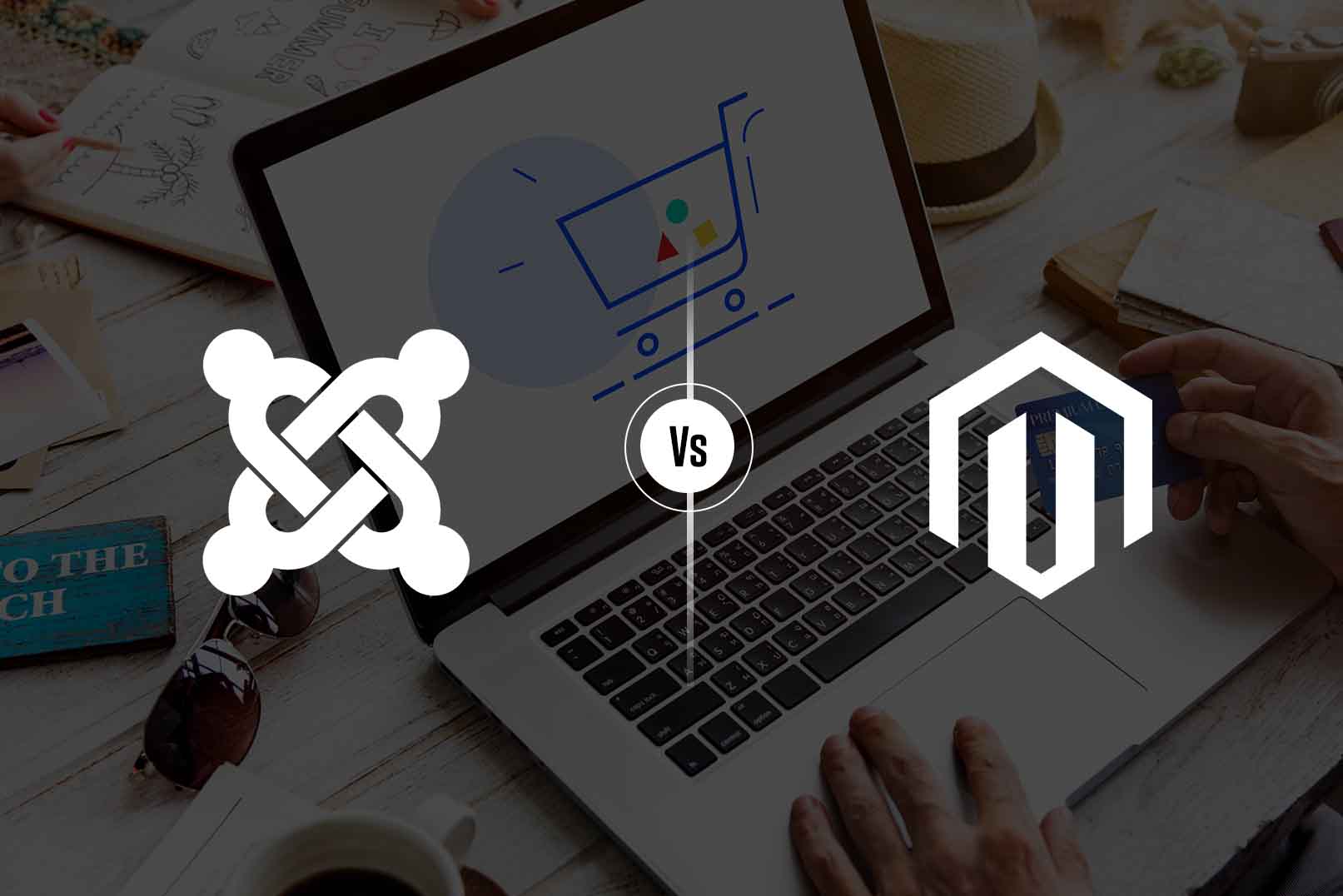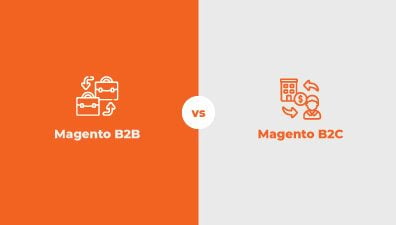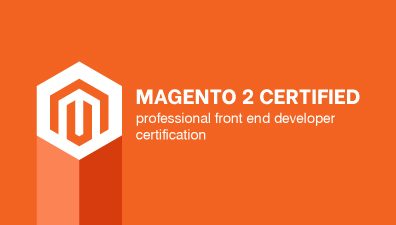When selecting the ideal eCommerce platform, like Magento or Joomla, online merchants often face a dilemma due to the plethora of available options. Magento, Joomla, WordPress, BigCommerce, and Shopify are just a few of the noteworthy platforms each offering unique features. It’s crucial for store owners to meticulously assess the capabilities and limitations of each system to determine the best fit for their specific needs, as no single solution suits every business. In this guide, we’ll focus on comparing Magento vs Joomla, highlighting their key similarities and differences to aid in your decision-making process.
Table of Contents
Magento vs Joomla: The Overview
Both platforms are renowned for their robust features and flexibility, catering to a wide range of needs from eCommerce functionality to content management. This overview provides a clear understanding of what each platform offers, helping you make an informed choice for your website.
Magento: The eCommerce Specialist
Founded in 2007 by Varien Inc., a U.S.-based private software firm, Magento is an open-source eCommerce platform. Crafted using PHP and built on the Zend Framework, it was officially launched in March 2008, aimed at providing a superior eCommerce solution for online retailers. Its robust nature makes it ideal for businesses looking to scale, offering extensive customization options, a wide array of functionalities, and a strong support community. Key features include:
- Advanced eCommerce Capabilities: Magento provides comprehensive tools for product management, customer segmentation, and inventory management, making it a one-stop shop for online merchants.
- Scalability: Designed to support businesses as they grow, Magento can handle large product catalogs and high customer volumes without compromising performance.
- Customization and Extensions: With a vast array of themes and extensions, Magento allows for high levels of customization to meet specific business needs.

Now under Adobe’s ownership, Magento has evolved over nearly two decades, powering numerous renowned companies such as Land Rover, HP, Nestle, and Canon. To date, Magento has been the foundation for over 750,000 webshops, boasting more than 2.5 million downloads and continually expanding its global footprint.
Regarded as a premier eCommerce platform, Magento provides two distinct versions tailored to meet diverse business needs: the Magento Community Edition and the Magento Enterprise Edition.
- The Magento Community Edition (Magento Open Source): This is available for free download and use. Despite being cost-free, it includes all the essential features necessary for a small business to operate a straightforward online store.
- Magento Enterprise Edition: It offers two advanced plan options – Magento Commerce and Magento Commerce Cloud. These plans provide a suite of enhanced features and functionalities beyond what the free version offers, catering to businesses seeking more sophisticated eCommerce solutions.
Joomla: The Versatile Content Manager
Launched in August 2005, Joomla is an open-source content management system designed for creating web content and websites. Developed by Open Source Matters, Inc. with the contribution of numerous volunteers, Joomla, like Magento, is crafted in PHP and operates on a model-view-controller framework. It’s an excellent choice for those looking to build a website with rich content and community features. Joomla’s main features include:
- User-Friendly Interface: Joomla offers an intuitive and straightforward administrative panel, making website management accessible to users of all skill levels.
- Extensibility: A wide range of extensions and templates are available, allowing users to add new features and customize the appearance of their site.
- Built-in Multilingual Support: Joomla supports multiple languages out of the box, which is ideal for creating multilingual websites.

Over time, Joomla has steadily risen in popularity, standing alongside other CMS giants like WordPress and Drupal. As of 2021, Joomla supports over 2.5 million active websites and has been downloaded more than 118 million times.
In addition to its free version, Joomla offers three upgraded plans: personal, business, and agency, catering to various needs. To establish a comprehensive eCommerce solution, Joomla requires the integration of plugins such as BigCommerce or Shopify.
Pros and Cons Differences between Magento vs Joomla
Recent data reveals that Magento holds a 2.32% share of the global market among leading eCommerce platforms, securing its position in the top 10 digital commerce technologies around the world. This achievement alone speaks volumes about its credibility and popularity.
Yet, to provide a more comprehensive understanding, we’ve delved deeper into the finer details. Below, we outline the advantages and disadvantages of integrating Magento into your business strategy.
Advantages of Magento
Magento offers a range of benefits for businesses looking to establish or enhance their online presence, particularly in the eCommerce sector. Some of the key advantages include:
- Robust eCommerce Features: Magento is specifically designed for eCommerce, providing comprehensive tools for product management, customer segmentation, and inventory tracking, enabling a sophisticated online shopping experience.
- Advanced Reporting and Analytics: Magento offers sophisticated tools for tracking sales, customer behavior, and website performance, enabling data-driven decisions.
- Marketing Tool Integration: Seamlessly integrates with numerous marketing tools, including options for gift cards and coupons, enhancing promotional strategies.
- Intuitive Catalog Management: Features an easy-to-use catalog management system, allowing efficient organization and modification of products.
- Quick and Easy Setup: Boasts a one-click installer, simplifying the initial setup process and saving valuable time.
- Extensive Customization Options: Supports over 10 native themes and 3,800+ extensions, providing ample opportunities to tailor the site to your specific needs.
Disadvantages of Magento
While Magento is a powerful eCommerce platform, it also comes with certain disadvantages that businesses should consider:
- Cost of Themes and Extensions: While Magento is an open-source platform, many of its themes, templates, and extensions come at a premium cost, which can add up for a fully customized site.
- Complex Customization: Customizing themes and navigating the technical aspects of Magento can be more challenging compared to other platforms, potentially requiring a steeper learning curve.
- Coding Skills Required: To effectively set up and customize Magento, some level of coding knowledge is often necessary, which may not be ideal for those without technical expertise.
- Hardware Dependent Performance: The performance and speed of a Magento site can be significantly influenced by the hardware it operates on, requiring robust hosting solutions for optimal functionality.
- Updates and Maintenance: Regular updates and maintenance are crucial for Magento sites to ensure security and functionality. This ongoing requirement can be a burden for some businesses.

Although Joomla might not have the same widespread popularity as Magento, it stands out as a strong competitor in the eCommerce sphere. It’s important to remember that Joomla’s primary function is as a Content Management System (CMS), but it also offers substantial eCommerce capabilities.
This versatility allows you to create a website that accommodates various shopping cart platforms like JooCart and JoomShopping. Here’s a look at some advantages and disadvantages of opting for Joomla for your online store.
Advantages of Joomla
Joomla offers several benefits as a content management system, particularly for users looking to create versatile and dynamic websites:
- Built-in SEO Functionality: Joomla comes equipped with SEO tools to help improve your site’s visibility and ranking on search engines.
- User-Friendly Interface: Joomla has a straightforward and intuitive administrative dashboard, making website management accessible for users of all skill levels.
- Open-Source and Free: As an open-source platform, Joomla is free to set up, offering a cost-effective solution for website creation.
- Unified Product and Content Management: Offers the convenience of managing both products and content efficiently from a single platform.
- Quick One-Click Installation: Simplifies the setup process with a fast, one-click installation feature.
- Extensive Extension Support: Provides access to over 5,000 extensions, both free and premium, allowing for enhanced site functionality and customization.
- Diverse Payment Gateway Integration: Supports a wide array of payment gateways, including popular options like PayPal and Google Checkout, facilitating easy and secure transactions.
Disadvantages of Joomla
While Joomla is a robust content management system, it has certain drawbacks that users might encounter:
- Customization Learning Curve: Users need a basic understanding of web development and design to fully exploit Joomla’s customization capabilities.
- Complex URL Configuration: Setting up user-friendly URLs is more complicated in Joomla compared to other platforms, which can be a hurdle for SEO optimization.
- Plugin Compatibility Issues: Users occasionally encounter glitches with plugin compatibility, which can affect website functionality and user experience.
- Frequent Updates: Regular updates are necessary for security and functionality, but they can be a hassle for users to continuously manage and may sometimes break existing features.
- Challenges with Categories: Adding and managing categories can be cumbersome and less intuitive in Joomla, potentially complicating content organization.
Magento vs Joomla: In-depth Comparison
Before making a decision between Magento vs Joomla for your online venture, it’s essential to delve into and understand all the aspects and components of these two prominent eCommerce platforms.
Each offers unique features, functionalities, and potential benefits tailored to different types of online businesses.
Features and Functionality
When comparing Magento vs Joomla, the key features and functionalities each platform offers are critical considerations. While both provide essential eCommerce capabilities necessary for an online store to operate effectively, Magento is often recognized for its superior range and quality of features. This distinction stems from the different foundational purposes of the two platforms.

Magento shines with an extensive array of built-in features out-of-the-box, catering to businesses of all sizes and ensuring a seamless shopping experience for customers. Key offerings of Magento Commerce include:
- Visual Merchandising: Allows for attractive and strategic product displays.
- PCI Compliance: Ensures secure payment processing meets industry standards.
- Order Management: Streamlines order processing for efficiency.
- Automated Targeting Rules: Enhances marketing efforts with personalized content and promotions.
- Multi-Source Inventory: Enables effective management of inventory from multiple locations.
- Advanced Catalog Search: Provides a powerful search tool for customers to find products quickly.
- B2B Functionality: Magento Commerce excels in serving B2B companies with features like expedited restocking, handling of large orders, payment on account, quick reordering, and requisition lists.
On the other hand, Joomla, primarily a robust content management system, offers excellent document management and blogging features, along with advanced multilingual functionalities. It stands out for:
- Document Management: Efficiently organizes and manages various digital content.
- Blogging Capabilities: Offers robust tools for creating and managing blog content.
- Advanced Multilingual Support: Facilitates the creation of multilingual websites directly out of the box.
However, to access premium eCommerce functionalities, online merchants using Joomla will typically need to independently download and install specific plugins or extensions. This means that while Joomla is inherently strong in content management, its eCommerce capabilities can be extended through additional customization.
SEO and Marketing
Magento, as an open-source and self-hosted platform, provides users with the flexibility to intervene and customize their website’s structure and design for improved SEO outcomes. It comes with a range of built-in SEO features and tools aimed at boosting a store’s visibility on search engines like Google. Key SEO capabilities of Magento include:
- Product Meta Tags: Allows for detailed descriptions and titles for better search engine recognition.
- Image Optimization: Reduces load times and improves user experience, contributing to better SEO rankings.
- Customizable URLs: Enables personalized, keyword-rich URLs for products and categories.
- Google Tools and 301 Redirects: Integrates seamlessly with Google’s suite of tools and allows for effective redirection of old URLs to new ones.
- Sitemap Generation: Automatically generates and updates sitemaps for submission to search engines.

In the realm of marketing, Magento offers sophisticated features to engage customers and boost sales, such as:
- Promotions: Implements cart price rules, gift card accounts, and other discount strategies.
- Private Sales and Events: Manages invitation-only sales and exclusive events for selected customers.
- Communication Tools: Includes customizable email templates, newsletter management, email reminders, and more.
- Customer Engagement: Utilizes tools like Engagement Cloud and exclusion rules to personalize user experience.
- User Content: Encourages customer interaction through reviews and ratings.
While Joomla supports a myriad of plugins designed to optimize your site for search engines, its SEO capabilities are generally not as extensive as Magento’s. Many of the SEO adjustments in Joomla need to be applied manually but can be simplified through various plugins. These plugins can:
- Manage Meta Tags: Help in the optimization and management of meta tags for better search engine visibility.
- Optimize Pages: Check for keyword saturation and guide on where to add no-follow tags to optimize each page.
- Analyze Performance: Provide insights into your website’s performance on search engines, helping to refine SEO strategies.
Although Joomla’s SEO and marketing tools are primarily plugin-dependent and may not match the comprehensive nature of Magento’s offerings, they still provide a solid foundation for improving your site’s search engine ranking and marketing efforts.
Ease of Use
While both platforms offer powerful eCommerce and content management capabilities, they can present challenges for users who aren’t tech-savvy.
Magento’s one-click installer makes the initial setup process relatively straightforward. However, the simplicity ends there for beginners with no web coding experience. Customizing and managing a Magento site typically requires a decent understanding of coding. The platform’s interface, while comprehensive, includes an array of options like reports, sales, promotions, products, and customers, all of which can be overwhelming for newcomers.
Additionally, Magento’s reliance on a local installation and FTP can be daunting for those without a technical background. While these features are not necessarily problematic for developers, they can pose significant challenges for non-technical users.
If you possess some coding skills, you’ll appreciate Magento’s self-hosting setup, which is quick and relatively straightforward. The extensive features and functionalities Magento offers are highly beneficial for those who have the skills to utilize them effectively.

Although Joomla is somewhat more accessible than Magento, setting up and customizing Joomla still requires a basic understanding of coding. The good news is that its learning curve isn’t as steep, and there are plenty of online tutorials available to help beginners navigate the setup and management of their site.
For non-developers, the front-end of Joomla is notably simpler to use. It allows for straightforward management of products without the need to switch between multiple tabs, making it more user-friendly for day-to-day operations. This accessibility makes Joomla the preferred choice for individuals or businesses without development resources who still want a degree of control over their site.
Pricing
Magento offers a free Open Source version that can be downloaded and used without any initial cost. However, for businesses looking to upgrade to the more feature-rich Magento Commerce, pricing becomes more complex. The cost of using Magento Commerce is dependent on the business’s annual gross merchandise value and the average order value.
For the Magento Commerce version, license fees start at $22,000 per year, and for the Magento Commerce Cloud Edition, the fees begin at $40,000 annually. While these costs might seem steep, it’s important to consider the advanced functionalities and potential return on investment these versions offer, particularly for larger businesses with extensive eCommerce needs.

Joomla, in contrast, provides a free version for basic website needs, making it an accessible option for individuals or small businesses. For those requiring more advanced features, Joomla offers three paid plans:
- Personal: starting from $99
- Business: starting from $199
- Agency: starting from $399
These plans are tailored to different user needs and provide additional support and functionalities.
It’s evident that operating a webshop on Joomla is generally more cost-effective than on Magento Commerce. Joomla’s pricing structure makes it a viable option for those with tighter budgets or smaller-scale operations. However, Magento’s high-end features, scalability, and robust eCommerce capabilities provide substantial value for its cost, particularly for businesses with significant online operations and sales volumes.
Performance and Speed
When comparing the performance and speed of Magento vs Joomla, it’s crucial to recognize that these factors significantly impact the online shopping experience. With over 40% of online users abandoning sites that take longer than 3 seconds to load, and 70% unlikely to return to a slow website, the stakes are high.
Magento is typically slower compared to Joomla. However, its performance can be significantly improved with the right strategies. Choosing a robust web hosting service and regularly updating to the latest Magento version, which often includes speed enhancements and new features, are key steps to boost performance. Additionally, minimizing the use of heavy plugins and optimizing images and files can further enhance Magento’s speed.

Joomla is renowned for its built-in performance-boosting functionalities. It generally delivers faster loading times out of the box compared to Magento. The speed of a Joomla site can be further optimized by maintaining minimal plugins, reducing HTTP requests, and ensuring images are well-optimized. Due to these aspects, Joomla often ranks highly in terms of performance and speed.
Scalability
When considering eCommerce solutions, scalability is a crucial factor, particularly for businesses planning to grow and handle high traffic volumes and large inventories during peak shopping periods like Black Friday or Cyber Monday. Both Magento vs Joomla are great options for businesses that want to grow more.
Magento stands out as a leading platform for scalability. It’s designed for online stores with a large and varied product range and a significant number of customer visits. The platform is particularly suited for businesses aiming to scale up quickly. With its robust inventory management system, Magento can support an extensive product catalog and handle up to 50,000 visits per hour. This makes it an ideal choice for businesses seeking to expand their capabilities and accommodate growth.

While primarily a content-focused system, Joomla is also capable of scaling to meet the needs of growing businesses. It can manage a substantial amount of content and accommodate numerous users. However, the scalability of a Joomla site largely depends on the right hosting, careful plugin management, and appropriate server hardware. With attention to these elements, Joomla can be a scalable option for businesses.
Website Customization
When it comes to website customization, Magento offers a cost-effective solution, making it a good choice for those with budget constraints. The Magento Admin provides users with the tools to personalize their websites without the need for extensive financial resources. Here are some key aspects of Magento’s customization options:
- Themes and Layouts: Magento offers a variety of themes, layouts, and color schemes to choose from. Users can easily brand their websites by selecting the most suitable design elements.
- Typography and Styling: Users have control over typography, buttons, background colors, and text colors, allowing them to fine-tune the visual aspects of their sites.
- Default Image Customization: Under the Design option in the configuration menu, Magento allows users to replace default images, providing an effortless way to reinforce their company’s branding.
Magento’s customization features are user-friendly and cost-effective, making it accessible to businesses with limited budgets.

Joomla takes a different approach to customization, focusing on an extensive ecosystem of themes, plugins, and extensions. Here’s how Joomla facilitates website customization:
- Themes and Plugins: Joomla provides a wide array of themes and a rich plugin ecosystem. Users can select themes that suit their website’s look and feel, and plugins allow for the addition of new features and functionalities.
- Template-Driven Customization: Templates play a central role in customizing the look, feel, and layout of Joomla websites, both on the front-end and in the back-end.
- User-Friendly Back-end: Joomla’s back-end interface includes a menu for modifying various parts of the page, ensuring that users can easily manage their website’s content and appearance.
- Diverse Extensions: Joomla offers a diverse range of extensions that users can search for by type, category, tags, compatibility, and more, allowing for seamless integration of additional functionalities.
In the comparison between Magento vs Joomla, Joomla does not have a central directory for themes, which means users may need to explore alternative sources for themes. However, Joomla’s extensive library of extensions compensates for this, providing users with ample customization options.
Support and Resources
When it comes to support between Magento vs Joomla, Magento offers different levels of assistance based on the edition you choose. Here’s an overview of the support options available:
- Magento Open Source (Community Edition): Users of the Community Edition have access to technical guidance from official sources, including the Magento Help Centre and Magento DevDocs. Additionally, they can seek help from the extensive community-based forums, such as Magento Forums, which boasts a community of over 450,000 members. Users can also receive support from authorized Magento partners, such as Magenest.
- Magento Commerce (Enterprise Edition): For users of the Enterprise Edition, Magento provides top-tier customer service and assistance. They can access live chat or email support to address any concerns or issues they encounter.

Joomla, like Magento, relies on community-based support to assist its users. Here are the primary support channels available to Joomla users:
- Community Portal: Joomla users can turn to the Community Portal for resources, discussions, and assistance with their questions and issues.
- User Groups: Joomla offers user groups where users can connect with like-minded individuals, share knowledge, and seek help from experienced Joomla enthusiasts.
- Email Support: Joomla provides email support to address user inquiries and provide guidance when needed.
Extension and Plugin Ecosystem
Magento boasts a robust Extension Marketplace that offers over 4,000 free and paid extensions. These extensions cover a wide range of categories, making it easy for users to find and install the functionality they need to enhance their eCommerce websites. Some of the categories include Shipping and fulfillment, Payment and security, Customer Support, Accounting and Finance, and Marketing, among others.
The extensions available on the Magento Marketplace undergo a thorough evaluation process to ensure quality and technical reliability. Additionally, users can access extensions from Magento’s official associates’ marketplaces, such as Magenest Store.
Joomla, on the other hand, boasts an even more extensive library of extensions, covering a wide variety of categories such as Migration and conversion, Search and indexing, Ads and affiliates, Structure and navigation, Access and security, and many more. Joomla users have access to a wealth of options to extend and enhance their websites.
Which One Is the Best Option for Your Business?
Below is the table that provides a quick overview of the key differences between Joomla vs Magento across various aspects. Your choice between the two platforms may depend on your specific needs and preferences in each category.
Aspect | Magento | Joomla |
Key Features | Offers robust built-in features for B2C and B2B | Requires plugins/extensions for eCommerce features |
SEO & Marketing | Provides built-in SEO tools and advanced marketing features | Requires plugins for SEO and marketing capabilities |
Ease of Use | Requires coding knowledge; not beginner-friendly | More beginner-friendly with online tutorials |
Pricing | Free (Magento Open Source) with varying fees for Magento Commerce | Free (Joomla) with paid plans available |
Performance & Speed | Slightly slower; improved with good hosting and updates | Known for good performance; depends on optimization |
Scalability | Scalable for large product catalogs and high traffic | Scalable with attention to hosting and plugins |
Website Customization | Customization options in Magento Admin | Templates and plugins for customization in Joomla |
Support and Resources | Community-based support and partner support | Community portal, user groups, and email support |
Extensions and Plugins | Magento Marketplace with 4,000+ extensions | Extensive library with categorized extensions |
As you can see, Magento stands out in terms of functionality and performance. It provides a robust set of features and is highly scalable, making it suitable for businesses with large product catalogs and high traffic. However, it’s not the best choice for beginners, as it requires significant development experience to manage effectively.
On the other hand, Joomla is relatively more user-friendly, especially on the front-end, making it accessible to newcomers. However, it does require some coding knowledge for back-end customization and management.
To choose the most suitable platform, here are some practices and criteria you should consider based on your business’s situation:
- Consider Your Expertise: Assess your technical skills. If you have coding and development experience, Magento may be a strong choice. If you’re new to web development, Joomla could be a more approachable option.
- Business Requirements: Define your specific business needs. If you require advanced eCommerce features and plan to scale rapidly, Magento is well-equipped. If your focus is primarily on content and you want a simpler setup, Joomla may suffice.
- Budget: Take into account the budget available for your eCommerce solution. Magento Commerce comes with licensing fees, while Joomla offers a free version with paid plans available. Ensure your choice aligns with your financial resources.
- Scalability: Consider your growth prospects. If you anticipate significant growth in terms of products and traffic, Magento’s scalability may be advantageous.
- Support and Community: Examine the availability of support resources. Both platforms have active communities, but Magento Commerce offers premium support options.
In the end, the best option for your business depends on a careful evaluation of these factors and aligning them with your specific goals and capabilities. Whether you prioritize performance, ease of use, or budget-friendliness, Magento vs Joomla each have their strengths to offer.
In Conclusion,
The choice between Magento vs Joomla ultimately boils down to your specific business needs and technical expertise. Both platforms have their strengths and weaknesses, making them suitable for different scenarios. Joomla isn’t primarily designed as an eCommerce platform, whereas Magento is tailor-made for eCommerce.
When making your decision, consider factors such as your technical skills, business requirements, budget, scalability needs, and the level of support and community available. If your business boasts an extensive product catalog and ambitious growth plans, Magento stands out with its plethora of robust features. Conversely, if your budget is limited, your focus is primarily on content-related offerings, and you have a smaller product range, Joomla emerges as the more suitable eCommerce solution.
In case you want to implement your eCommerce strategy and store on the Magento platform, don’t hesitate to contact our Magento team or discover our elite Magento development services to know more about our solutions for your business. With numerous years of experience and specialized in Adobe Commerce for the APAC region, we are confident to deliver the most optimal and customized solutions for your company.











